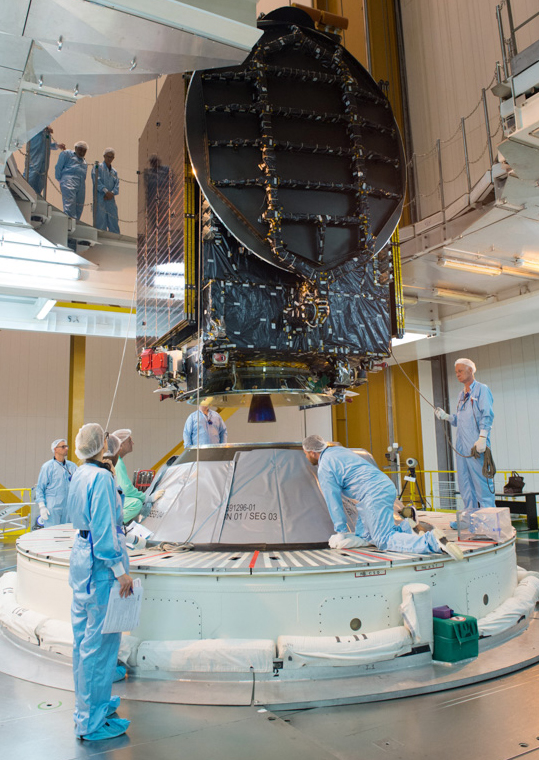25.07.2016
Intelsat 33e arrives at the Spaceport for Arianespace’s August launch with Ariane 5

Both satellite passengers for Ariane 5’s August 24 launch are now in French Guiana
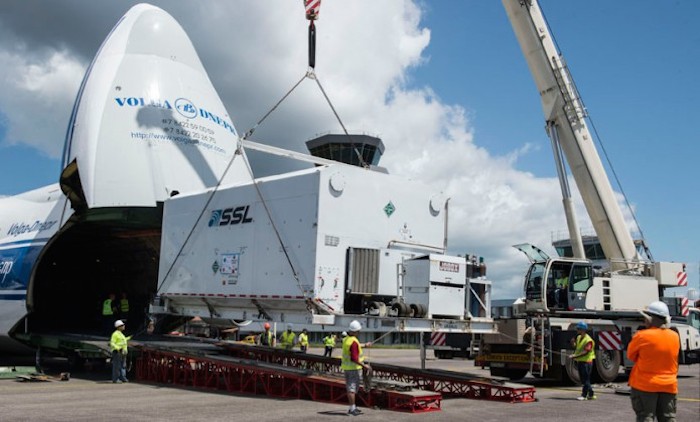
Two Intelsat satellites are prepared for their upcoming Arianespace Ariane 5 launch

Launcher and payload preparations advance for Arianespace’s next Ariane 5 mission

Riding atop one of two operational launch tables at the Spaceport, Ariane 5 is shown at left during today’s Spaceport transfer from the Launcher Integration Building (visible in the background) to the Final Assembly Building; while Intelsat 33e undergoes its fueling process inside the S5 payload preparation facility (photo at right).
Ariane 5 is “on the move” as launcher and payload preparations continue in parallel for Arianespace’s August 24 mission at the service of international satellite operator Intelsat.
In a milestone reached today at the Spaceport in French Guiana, Ariane 5 was rolled out from the Launcher Integration Building – where its core cryogenic stage, two solid boosters and cryogenic upper stage were mated – to the Final Assembly Building. This process formally transferred authority for the heavy-lift vehicle to Arianespace from production prime contractor Airbus Safran Launchers.
With Ariane 5 now under Arianespace’s responsibility, the launcher is in position to receive its Intelsat 33e and Intelsat 36 payloads – both of which have been advancing through their own pre-flight preparations at the Spaceport. During the latest activity, Intelsat 33e this week began receiving its propellant load inside the S5 payload preparation facility.
Both spacecraft on this upcoming mission to geostationary transfer orbit – which is designated Flight VA232 in Arianespace’s launcher family numbering system – will be operated by Intelsat following their deployment by Ariane 5.
Intelsat 33e will ride in the upper position of Ariane 5’s payload configuration, to be released first during the flight sequence. Produced by Boeing Space Systems, it is the second spacecraft of the next-generation Intelsat EpicNG series and integrates one of the most advanced digital payloads available commercially today. The first EpicNG-series satellite – Intelsat 29e – was successfully orbited on an Ariane 5 mission performed in January.
Intelsat 36, which was built by SSL (Space Systems Loral), is to be installed in the Ariane 5’s lower payload position. After reaching its target orbit, the satellite will enhance Intelsat’s premier direct-to-home neighborhood in Africa.
Quelle: arianespace
-
Update: 14.08.2016
.
New payload preparation milestones bring Ariane 5’s upcoming mission closer to liftoff

The latest payload preparations for Ariane 5’s Flight VA232 are captured above. In the photo at left, Intelsat 33e is shown being lowered for integration atop the SYLDA dual-passenger dispenser system; while at right, the Intelsat 36 co-passenger is “topped off” with its onboard propellant.
The two satellite passengers for Ariane 5’s August 24 flight – both of which will be orbited at the service of global operator Intelsat – are advancing through their payload preparation phases during parallel activity at the Spaceport in French Guiana.
Designated Flight VA232 in Arianespace’s numbering system, the upcoming mission will loft Intelsat 33e and Intelsat 36 to geostationary transfer orbit. It is scheduled as the company’s sixth launch to be performed in 2016, as well as the fourth this year using a heavy-lift Ariane 5. Arianespace’s full launcher family is rounded out by the medium-weight Soyuz and light-lift Vega.
Intelsat 33e – the first of the two payloads to arrive in French Guiana – has completed its initial checkout, and during preparations carried out yesterday, was installed on the launch vehicle’s SYLDA dual-passenger dispenser system. The latter step was performed in the Spaceport’s Final Assembly Building and positions Intelsat 33e for the upper slot of Ariane 5’s payload arrangement.
As the second spacecraft of the next-generation Intelsat EpicNG series, Intelsat 33e – which was produced by Boeing – integrates one of the most advanced commercially-available digital payloads in the world. The first Intelsat EpicNGsatellite, Intelsat 29e, was successfully delivered to geostationary transfer orbit on an Ariane 5 mission performed in January.
Flight VA232’s Intelsat 36 co-passenger marked an important pre-launch milestone of its own yesterday with the loading of onboard propellant, which occurred in the S5A hall of the Spaceport’s S5 payload preparation facility. Following its upcoming transfer to the Final Assembly Building, this spacecraft will be integrated as the August 24 mission’s lower payload.
Built by SSL (Space Systems Loral), Intelsat 36 will enhance Intelsat’s premier direct-to-home neighborhood in Africa after reaching its final orbital position.
---
Preparations for Arianespace’s upcoming Ariane 5 flight move into their final phase at the Spaceport

The parallel preparations for Intelsat 33e and Intelsat 36 are highlighted above. In the photos at left and center, the protective payload fairing is positioned and then lowered over Intelsat 33e inside the Spaceport’s Final Assembly Building – creating the upper portion of Ariane 5’s dual-passenger configuration; while at right, Intelsat 36 arrives at the same building for its integration on the launch vehicle’s core section.
The upper portion of Ariane 5’s dual-passenger configuration is now complete, with the Intelsat 33e satellite and SYLDA dispenser system encapsulated inside their protective payload fairing in preparation for an August 24 liftoff from French Guiana.
This activity took place in the Spaceport’s Final Assembly Building for Ariane 5, adjacent to where the heavy-lift launcher is waiting to receive both Intelsat 33e and the mission’s other passenger, Intelsat 36 – which was transferred into the same building from the S5 payload preparation facility yesterday.
The integration process’ next step will occur when Intelsat 36 is positioned on the launcher’s core section, allowing the configuration to be completed with installation of the Intelsat 33e/SYLDA/fairing combination atop it.
A dedicated launch for global satellite operator Intelsat
During the August 24 flight sequence, the payload fairing will be jettisoned first at approximately three minutes into the mission, followed by deployment of Intelsat 33e at the 28-minute mark. The SYLDA dispenser is then to be released, allowing Intelsat 36’s subsequent separation to complete the mission 41 minutes after liftoff.
Arianespace’s upcoming Ariane 5 flight, designated VA232 in the company’s launcher family numbering system, is scheduled during a launch window that opens at 6:55 p.m. and continues through 7:40 p.m., local time in French Guiana.
Intelsat 33e, produced by Boeing Space Systems, is the second Intelsat EpicNG-series spacecraft – following the first, Intelsat 29e, successfully orbited on an Ariane 5 mission performed in January. The satellite has a liftoff mass estimated at 6,575 kg. and will operate from an orbital position of 60 deg. East after launch.
The Intelsat 36 passenger, which was built by SSL (Space Systems Loral), has an estimated liftoff mass of 3,250 kg. After reaching its target orbit, the satellite will enhance Intelsat’s premier direct-to-home neighborhood in Africa from a 68.5 deg. East orbital slot.
Quelle: arianespace
-
Update: 18.08.2016
.
Ariane says ready for Intelsat satellite launch
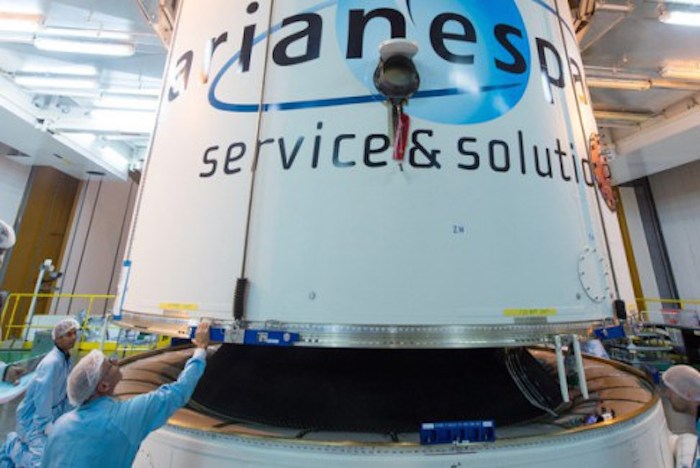
Deployed first during the mission to geostationary transfer orbit, Intelsat 33e – which has an estimated lift-off mass of 6,600 kg. – is the second satellite in Intelsat’s next-generation high-throughput Intelsat Epic NG series. It joins Intelsat 29e, launched by Arianespace aboard another Ariane 5 in January. Built by Boeing using a 702MP spacecraft platform and operating from an orbital slot of 60 degrees East, Intelsat 33e’s Ku- and C-band coverage will meet broadband demand for carrier-grade telecom services, enterprise networks, aeronautical connectivity and certain media services.
The satellite’s Ku-band spot beams are to provide broadband services for Europe, Africa, the Middle East and Asia, while a Ku-band wide beam provides broadcast coverage of Europe, the Middle East and Asia. Its C-band spot beams will cover high-traffic telecommunications centres in Europe, Central Africa, the Middle East, Asia and Australia, while a C-band wide beam is to deliver coverage over sub-Saharan Africa for data and media services.
Completing Arianespace’s Flight VA232 at 41 minutes after lift-off will be the separation of Intelsat 36, which is designed to enhance Intelsat’s media neighborhoods serving the South African and Indian Ocean region. Manufactured by Space Systems/Loral on a 1300 platform, its Ku-band payload was built to support the MultiChoice direct-to-home service in South Africa. Intelsat 36 will be position at the orbital slot of 68.5 degrees East, where the satellite will be co-located with Intelsat 20, which was launched by Arianespace in August 2012.
Quelle: telecompaper
-
Two Intelsat payloads are installed on Ariane 5 for Arianespace’s next heavy-lift launch
The Ariane 5 for Arianespace’s upcoming mission at the service of Intelsat is now complete following integration of the Intelsat 33e and Intelsat 36 satellites – readying the launch vehicle for liftoff on August 24 from French Guiana.
Designated Flight VA232, the mission will be Arianespace’s sixth launch in 2016, and the fourth using a heavy-lift Ariane 5 this year. Its two payloads will be the 57th and 58th satellites lofted by Arianespace for Intelsat, continuing a relationship that began in 1983 as the U.S.-based operator developed a network to deliver high-quality, cost-effective video and broadband services worldwide.
Ariane 5 receives its payloads in the Final Assembly Building
During preparation activity for Flight VA232 in the Spaceport’s Final Assembly Building, Intelsat 36 was installed atop the Ariane 5’s core stages on Friday, positioning the 3,250-kg.-class spacecraft as the mission’s lower passenger.
It was followed this weekend by the lowering of the launcher’s “composite” – consisting of Intelsat 33e, together with Ariane 5’s SYLDA dual-payload deployment system and the protective payload fairing – into position over Intelsat 36.
Deployed first during the mission to geostationary transfer orbit, Intelsat 33e – which has an estimated liftoff mass of 6,600 kg. – is the second satellite in Intelsat’s next-generation high-throughput Intelsat Epic NG series. It joins Intelsat 29e, launched by Arianespace aboard another Ariane 5 in January.
“Epic” coverage by Intelsat 33e
Built by Boeing using a 702MP spacecraft platform and operating from an orbital slot of 60 deg. East, Intelsat 33e’s Ku- and C-band coverage will meet broadband demand for carrier-grade telecom services, enterprise networks, aeronautical connectivity and certain media services.
The satellite’s Ku-band spot beams are to provide broadband services for Europe, Africa, the Middle East and Asia, while a Ku-band wide beam provides broadcast coverage of Europe, the Middle East and Asia. Its C-band spot beams will cover high traffic telecommunications centers in Europe, Central Africa, the Middle East, Asia and Australia; while a C-band wide beam is to deliver coverage over sub-Saharan Africa for data and media services.
Intelsat 36 coverage for South Africa and the Indian Ocean region
Completing Arianespace’s Flight VA232 at 41 minutes after liftoff will be the separation of Intelsat 36, which is designed to enhance Intelsat’s media neighborhoods serving the South African and Indian Ocean region.
Manufactured by SSL (Space Systems/Loral) on a 1300 platform, its Ku-band payload was built to support the MultiChoice direct-to-home service in South Africa.
Intelsat 36’s C-band relay capacity provides in-orbit resilience for the company’s video content distribution neighborhood at the orbital slot of 68.5° East – where the satellite will be co-located with Intelsat 20, which was launched by Arianespace in August 2012.
Quelle: arianespace
-
Update: 23.08.2016
-
ARIANESPACE FLIGHT VA232
Intelsat 33e and Intelsat 36
For its sixth launch of the year, and the fourth by Ariane 5 in 2016, Arianespace will orbit the Intelsat 33e and Intelsat 36 satellites for operator Intelsat. Following the successful launch of Intelsat 29e on January 27, this is Arianespace’s second Ariane 5 “all-Intelsat” launch, based on more than 30 years of partnership.
278th mission by the Arianespace launcher family.
The liftoff will be from the Ariane Launch Complex (ELA) in Kourou, French Guiana (South America).
 |
Liftoff is planned on Wednesday, August 24, 2016 as early as possible within the following launch window: Webcast starts 15 minutes before. You can also watch the video transmission live on your iPad, iPhone or Android 4+ devices, the Arianespace HD App is available for free. Follow the lauch live: www.arianespace.com |
Quelle: arianespace
-
Update: 25.08.2016
.
Erfolgreicher Start von Ariane-5 mit Intelsat 33e+Intelsat 36
-

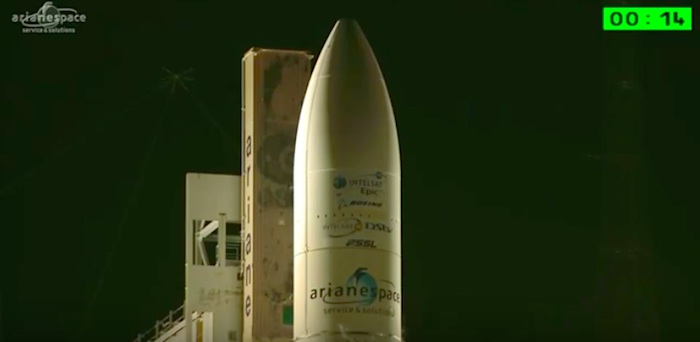

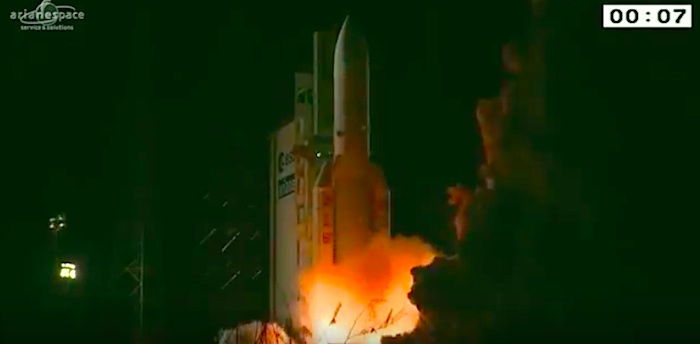

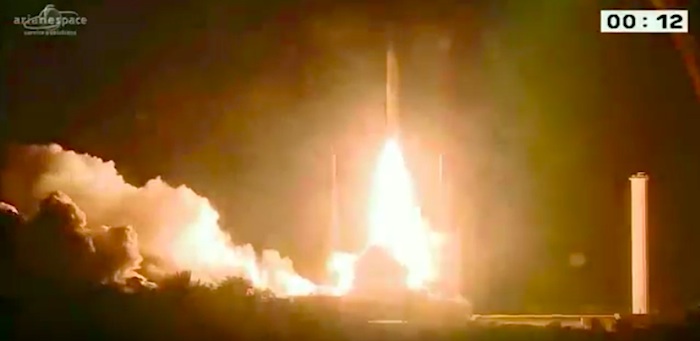

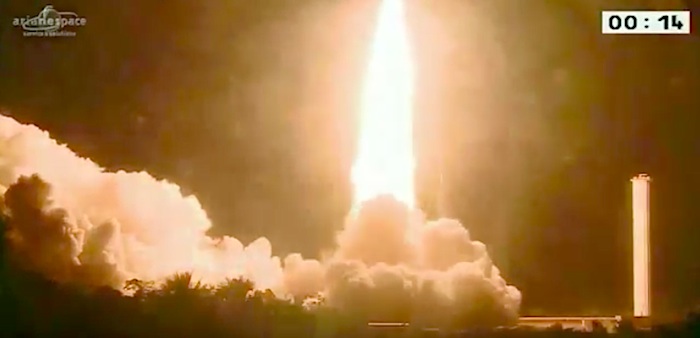
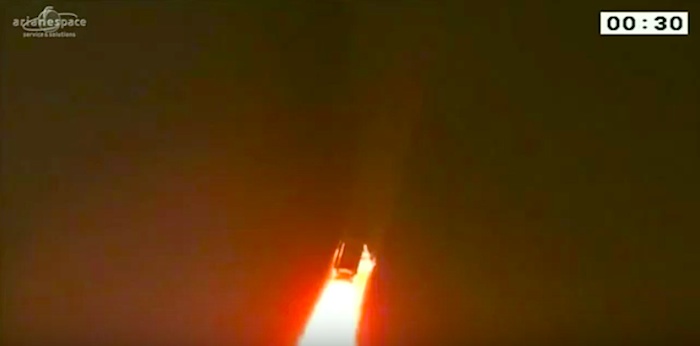
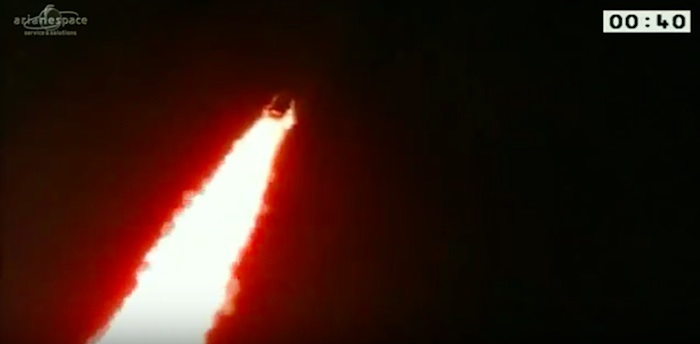
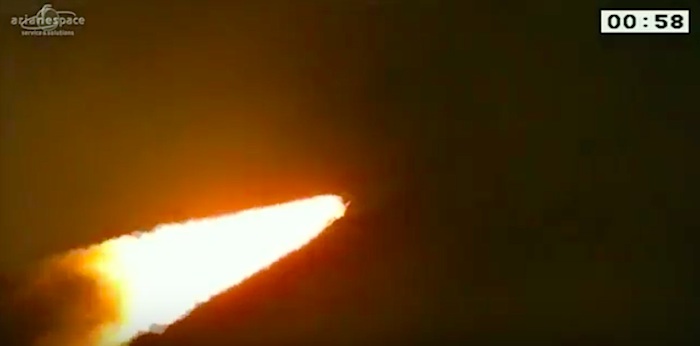
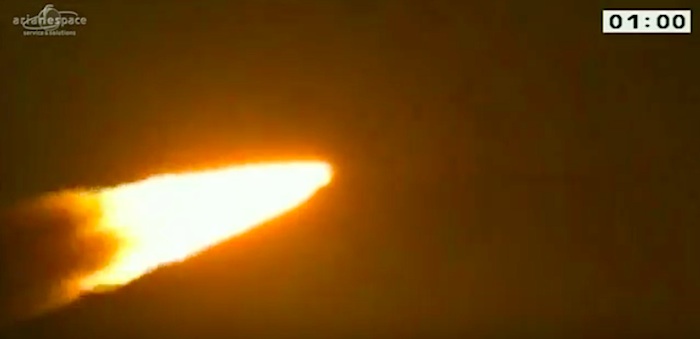
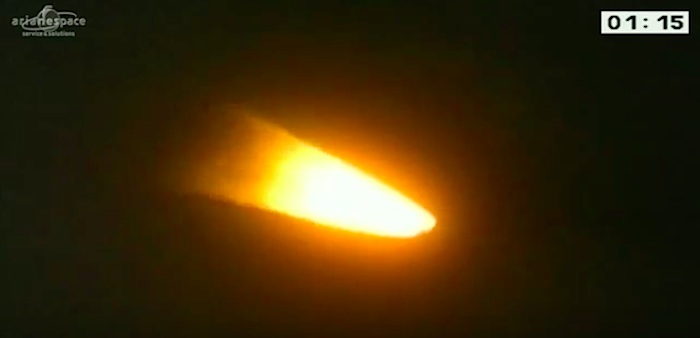
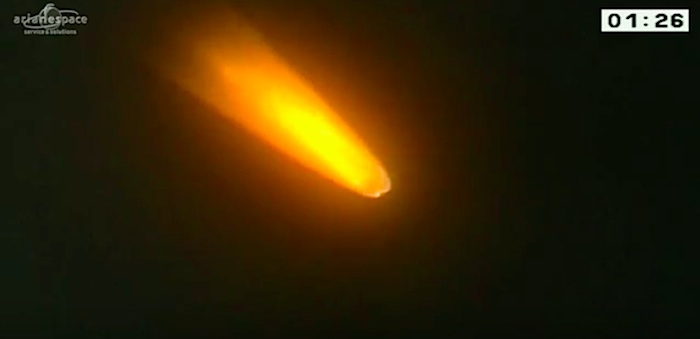
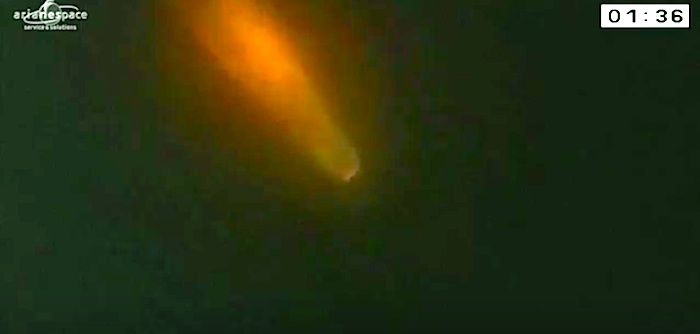
---
Intelsat “doubles down” with Arianespace for an Ariane 5 dual success

Flight VA232 was performed from the Spaceport’s ELA-3 launch zone, using Arianespace’s heavy-lift Ariane 5 workhorse launcher.
Two telecommunications relay satellites were orbited today for Intelsat on an Ariane 5, extending Arianespace’s 30-plus-year partnership with this U.S. operator while continuing the workhorse launcher’s track record of success and setting a new payload-lift record.
During a 41-minute mission from the Spaceport in French Guiana, Ariane 5 deployed Intelsat 33e and Intelsat 36 into geostationary transfer orbit, making them the 57th and 58th Intelsat payloads lofted by Arianespace for the satellite service provider since 1983.
With this evening’s launch – designated Flight VA232 – Intelsat retains its position as Arianespace’s no. 1 customer on missions to geostationary transfer orbit (GTO), with the launch services provider having lofted 50 percent of all Intelsat satellites in operation today.
Profound confidence in Arianespace
“Intelsat entrusted two satellites to Arianespace on a single mission; this betokens a profound confidence in the reliability and flexibility of the Ariane 5 launcher,” explained Arianespace Chairman and CEO Stéphane Israël.
Israël added the partnership will continue next year with Arianespace’s launch of two more satellites – Intelsat 32e and Intelsat 37e.

Ken Lee, Intelsat’s Senior Vice President of Space Systems, congratulates members of the Arianespace launch team on today’s Ariane 5 dual mission success.
After confirmation of the two satellites’ separation on Flight VA232, Ken Lee, Intelsat’s Senior Vice President of Space Systems, thanked Arianespace for the mission.
“Ariane has the reputation of delivering, and today it delivered not one, but two of our satellites successfully into orbit,” Lee commented from the Spaceport’s Jupiter control center. “We truly appreciate our partnership, and the fact that we have marked another flawless mission together!”
This mission also highlighted continuous improvement in the launcher’s payload lift performance, with 10,735 kg. delivered today to geostationary transfer orbit – topping the record of 10,730 kg., set during the most recent Ariane 5 flight, performed in June.
Ariane 5’s first mission with Airbus Safran Launchers fully operational
In another milestone, the vehicle utilized this evening – no. 87 in the series of heavy-lift launchers – was the first since Ariane 5 prime contractor, and Arianespace main shareholder, Airbus Safran Launchers (ASL) became fully operational on July 1, assuming its full scope of activity.
“I would like to thank Airbus Safran Launchers and all the European industry for contributing more than ever to Arianespace successes,” Israël said.
The Arianespace Chairman and CEO also recognized this latest achievement’s contributions from the European Space Agency (responsible for development of the Ariane, Soyuz and Vega launcher programs), as well as France’s CNES space agency (the qualification authority for Ariane 5 and operating partner at the Spaceport).
“And of course, bravo to my Arianespace colleagues for the outstanding success – the sixth of this year!” Israël added.
A “red-white-and-blue” Flight VA232
Flight VA232 had a strong U.S. angle, as Arianespace’s customer and the manufacturers of both satellites are American.
Intelsat operates its globalized network from headquarters in McLean, Virginia; Intelsat 33e was produced by Boeing in El Segundo, California; while Intelsat 36 also was manufactured in California by SSL (Space Systems Loral) at Palo Alto.
“With this flight, Arianespace has launched a total of 87 satellites for U.S. operators and 177 satellites manufactured in the U.S. since 1980,” Israël explained. “It is appropriate that we are celebrating our 30th anniversary of the Arianespace Washington, D.C. office this year.”
Meeting broadband demand and serving Intelsat’s media neighborhoods
Intelsat 33e was the first payload deployed during today’s Ariane 5 mission, on its way to an orbital slot of 60 deg. East – from which the spacecraft’s Ku- and C-band coverage will meet broadband demand for carrier-grade telecom services, enterprise networks, aeronautical connectivity and media services once fully operational. Its coverage area includes Europe, the Middle East, Africa and the Asia-Pacific region.

Flight VA232 was U.S.-centric, with the customer (Intelsat) and manufacturers of both satellite payloads (Boeing and SSL) all based in the United States.
Built by Boeing using a 702MP spacecraft platform, Intelsat 33e is the second satellite in Intelsat’s next-generation high-throughput Intelsat EpicNG series – joining Intelsat 29e, which was launched by Arianespace aboard another Ariane 5 in January.
The Intelsat 36 co-passenger – which is based on SSL’s 1300 platform – was released next, completing Flight VA232. Designed to enhance Intelsat’s media neighborhoods serving the South African and Indian Ocean region, the satellite will operate from a 68.5 deg. East orbital position – co-located with Intelsat 20, which was launched by Arianespace in 2012.
Ariane 5’s delivery of its Intelsat 33e and Intelsat 36 payloads on Flight VA232 was performed with the following estimated parameters at orbital injection:
– Perigee: 248.7 km. for a target of 249.0 km.
– Apogee: 35,858 km. for a target of 35,879 km.
– Inclination: 5.98 deg. for a target of 6.00 deg.
The half-way mark in Arianespace’s 2016 launch schedule
As Arianespace’s sixth of 11 flights planned during the year using its launcher family – which consists of the heavy-lift Ariane 5, medium-lift Soyuz and lightweight Vega – today’s success brings the company to the half-way point in its 2016 mission activity.
It follows Ariane 5 missions performed on January 27 (carrying Intelsat 29e as a dedicated single payload), March 9 (EUTELSAT 65 West A) and June 18 (EchoStar XVIII and BRIsat); plus Soyuz missions on April 25 (with Sentinel-1B as the primary passenger) and May 24 (two Galileo constellation satellites).
Arianespace’s next Spaceport mission is a Vega flight scheduled for September 15, carrying the PerúSAT-1 Earth observation satellite at the service of Airbus Defence and Space (on behalf of the Peruvian government), and four Earth imaging satellites for Terra Bella.
Quelle: arianespace

